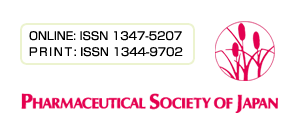| |
Software Requirements
Microsoft Internet Explorer 5.01 or higher and Netscape Navigator 4.75 or higher are recommended. |
|
 |
J.Health Sci., 52(6), 794-799, 2006
Antiplasmodial Activity and Acute Toxicity of N-alkyl and N-benzyl-1,10-Phenanthroline Derivatives in Mouse Malaria Model
Mahardika Agus Wijayanti,*, a
Eti Nurwening Sholikhah,b
Iqmal Tahir,c
Ruslin Hadanu,c
Jumina,c Supargiyono,a
and Mustofab
aDepartment of Parasitology Faculty of Medicine,
bDepartment of Pharmacology and Toxicology Faculty of Medicine, and
cDepartment of Chemistry Faculty of Mathemathics and Natural Sciences, Gadjah Mada University, Yogyakarta-Indonesia, Indonesia
Previous study on in vitro antiplasmodial activity of diaza phenanthrene analogs indicated that the 1,10-phenanthroline skeleton represents a potential antimalarial leader compound. Based on those skeletons, six derivatives of N-alkyl and N-benzyl-1,10-phenanthroline were synthesized and the in vitro antiplasmodial activities was evaluated. This paper reported the in vivo antiplasmodial activity study of the 1,10-phenanthroline derivatives performed by the classical 4-day suppressive test against Plasmodium berghei. Acute toxicity of each compound was determined after a single injection of the compound intraperitoneally in Swiss mice. The 50% effective dose (ED50) of the compound ranged from 2.08 to 50.93 mg/kg of body weight, and the therapeutic indices (TIs) ranged from 2.06 to 7.57 except (1)-N-benzyl-1,10-phenantrolinium iodide, which was 58.38. All of the 1,10-phenanthroline derivatives had in vivo antiplasmodial activity and (1)-N-benzyl-1,10-phenantrolinium iodide was the most potent.
|
|

